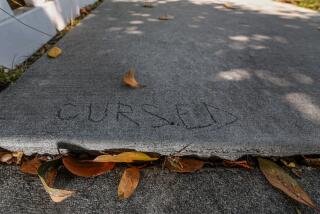Calabasas Park Weeds--or Ground Cover--Get Official Inspection : Landscaping: Residents pay about $1 million a year to the county to maintain their tract’s parks, hillsides and common areas, money some say is not well-spent.
On a shadeless Calabasas street snaking between ridgelines above the San Fernando Valley, Michael Fichera clutched a handful of freshly plucked greenery, the dirt still clinging to the roots, and demanded to know: What was it--exactly?
Was it, as Fichera insisted, an unwanted weed growing wild among a developer’s landscaping, choking out all desirable plants?
Or was it, as Curt Robertson suggested, ground cover, no matter how ugly, planted intentionally by the developer?
Failing to reach a consensus on what was weed and what was landscaping was the first of many questions left unresolved as Fichera, a local homeowner, and Robertson, a Los Angeles County official, toured areas of Calabasas Park that residents complain are neglected by the county.
Fichera and other members of the Calabasas Park Homeowners Assn. say they are getting ripped off by the county, which they pay to maintain about 260 acres of common land such as street medians, parks, hillsides and a 23-acre lake. Each of the 2,400 households pays about $375 a year for the service.
“This homeowners association pays, in essence, $1 million a year for the county to maintain these slopes,” Fichera said. “This is the treatment we end up with--substandard treatment. That’s the long and the short of it.”
To Fichera, the weed in his hand was a symbol of that ill treatment. The association aired such complaints before the Board of Supervisors last week, prompting Supervisor Ed Edelman to question whether the county landscapers were neglecting their duties. The next day, Fichera and Robertson agreed to tour the hillsides together to discuss the problem.
In some ways, it is a problem of perception.
To an outsider, the meandering streets of Calabasas are the picture of suburban perfection: greenbelts form moats of manicured grass around tracts of million-dollar homes, lush landscaping blankets hillsides and neighborhood parks remain free of graffiti.
But those who live there see hillsides in danger of sliding, grass in need of watering, trees withering from neglect, broken sprinklers and algae-filled ponds.
And so it was that Robertson and Fichera spent an afternoon playing verbal Ping-Pong, spending much of their time arguing over minutiae such as the alleged weed.
“This is what the developer planted,” Robertson, administrative services manager for the Department of Parks and Recreation, said as he surveyed the hillside.
“Oh, I don’t think so,” countered Fichera, a board member of the Calabasas Park Homeowners Assn.
“Well, in a lot of places, it is considered a weed,” Robertson conceded, about to begin another sentence when Fichera interrupted with: “According to Sperling Nursery, I brought this to them, and they said this is a weed and suggested a Roundup-type treatment.”
And so on.
For the record, neither man could conclusively identify the mystery plant, a short spindly thing with occasional flowers.
Back and forth they went over whether this or that hillside’s vegetation was dying or healthy, whether this or that spot of grass was more green than brown. What looked fine to Robertson was generally unacceptable to Fichera.
Robertson, whose department oversees about 40 landscape maintenance districts, said maintenance of Calabasas’ open space is on a par with the rest of the county, maybe even better. He agreed that the county could supervise its contractors more closely, but said to do so would require more inspectors.
To keep a more watchful eye in Calabasas would mean increasing the number of inspectors--and thereby raising the fee each household pays--or taking one away from another area, Robertson said.
As the two argued politely, Sara and Sydney Keith roared up in their car to complain about a landslide in their yard that needed to be cleaned up. The rubble had been there since the March rains.
The couple said Fichera and Robertson looked as if they knew something about landslides. After Sara Keith recited a long tale about sandbags and mud in her back yard, Robertson promised to look into the problem.
As far as Fichera was concerned, the Keiths’ complaints had proved his point--the hillsides were not properly maintained.
Robertson did not agree.
Returning to his original complaint, Fichera insisted that the mystery plant contributed to erosion problems because it dies in winter and no longer holds the soil together. Before the county began maintaining the slopes, “it did not have all this damn stuff,” he said, still clutching the plant.
“I say it did,” Robertson said.
“No, it didn’t.”
And so on.
More to Read
Sign up for Essential California
The most important California stories and recommendations in your inbox every morning.
You may occasionally receive promotional content from the Los Angeles Times.










